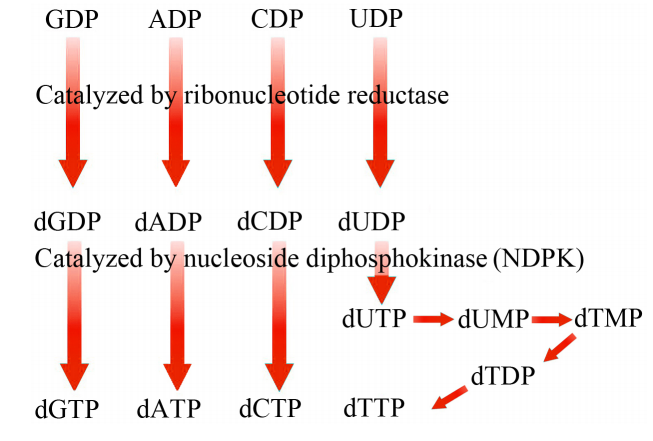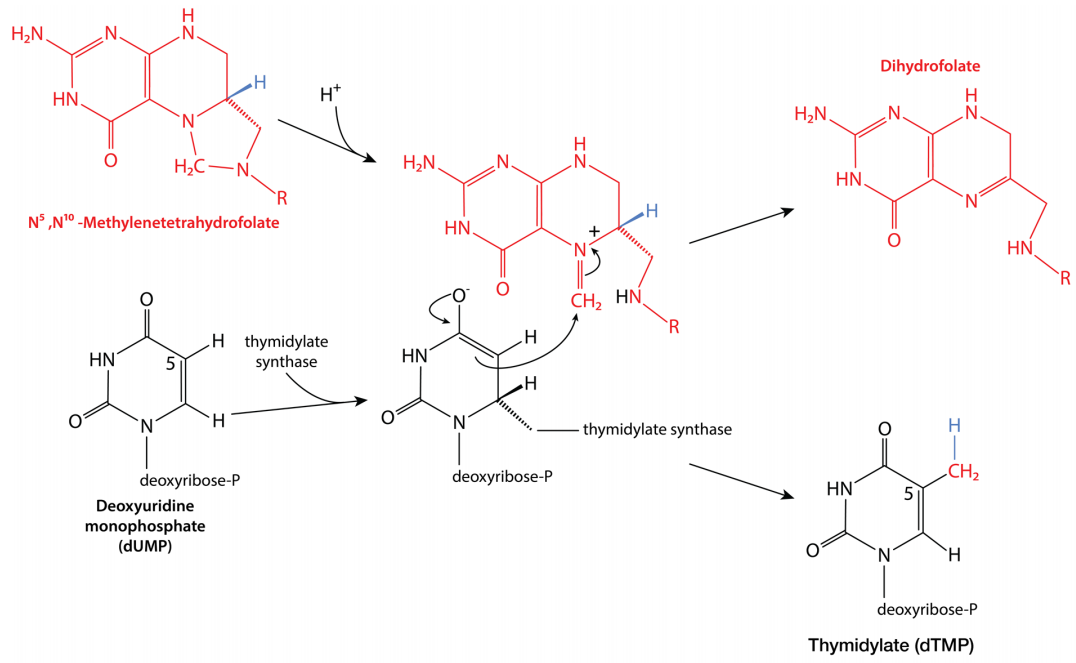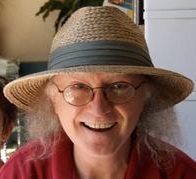7.12: Biosíntesis de desoxirribonucleótido de novo
- Page ID
- 53698
La síntesis de desoxirribonucleótidos de novo requiere de una interesante enzima llamada ribonucleótido reductasa (RNR). La RNR cataliza la formación de desoxirribonucleótidos a partir de ribonucleótidos. La forma más común de RNR es la enzima Tipo I, cuyos sustratos son ribonucleósidos difosfatos (ADP, GDP, CDP o UDP) y los productos son desoxirribonucleósidos difosfatos (DAdP, dGDP, dCDP o dUDP). Los nucleótidos de timidina se sintetizan a partir de duDP RNR tiene dos pares de dos subunidades idénticas: R1 (subunidad grande) y R2 (subunidad pequeña). R1 tiene dos sitios de unión alostéricos y un sitio activo. R2 forma un radical tirosina necesario para el mecanismo de reacción de la enzima.

Debido a que una sola enzima, RNR, es responsable de la síntesis de los cuatro desoxirribonucleótidos, es necesario contar con mecanismos para asegurar que la enzima produzca las cantidades correctas de cada dNDP. Esto significa que la enzima debe responder a los niveles de cada desoxinucleótido, haciendo selectivamente más de los que escasean, e impidiendo la síntesis de los que son abundantes. Estas demandas se satisfacen al contar con dos mecanismos de control separados, uno que determina sobre qué sustrato se actuará y otro que controla la actividad catalítica de la enzima.

La ribonucleótido reductasa se regula alostéricamente a través de dos sitios de unión: un sitio de unión de especificidad (se une a los dNTP y controla qué sustratos se une la enzima y, por lo tanto, qué desoxirribonucleótidos se hacen) y un sitio de unión a la actividad (controla si la enzima está activa o no - ATP activa, dATP inactiva).
Cuando un trifosfato de desoxipirimidina, dTTP es abundante, se une al sitio de especificidad e inhibe la unión y reducción de los difosfatos de pirimidina (CDP y UDP) pero estimula la unión y reducción del PIB por la enzima. Por el contrario, la unión del trifosfato de desoxipurina, ATP estimula la reducción de pirimidina difosfatos, CDP y UDP.
Los estudiantes a veces confunden el sitio activo de RNR con el sitio de actividad. El sitio activo es donde se cataliza la reacción, y también podría llamarse sitio catalítico, mientras que el sitio de actividad es el sitio de unión alostérico para ATP o dATP que controla si la enzima está activa.
La síntesis de dTTP por la vía de novo toma una vía intrincada de dUDP a dTP a dUMP a dTMP, luego dTDP y finalmente dTTP. La conversión de dUMP a dTMP, requiere un derivado tetrahidrofolato y la enizma timidilato sintasa. En el proceso, el dihidrofolato se produce y debe ser convertido de nuevo en tetrahirdolato para mantener la síntesis de nucleótidos ocurriendo. La enzima involucrada en la conversión de dihidrofolato en tetrahidrofolato, dihidrofolato reductasa (DHFR), es una diana de fármacos anticancerígenos como metotrexato o aminopterina, que inhiben la enzima.


